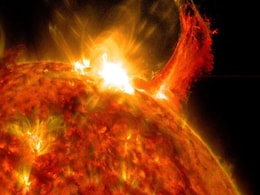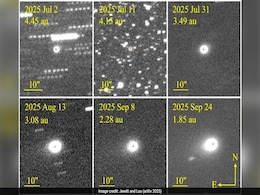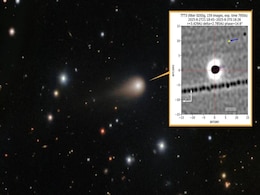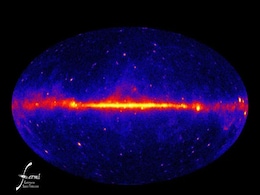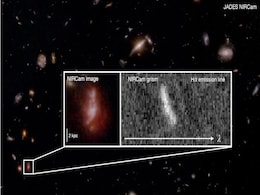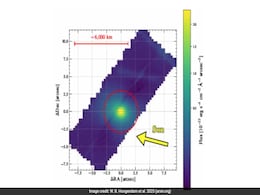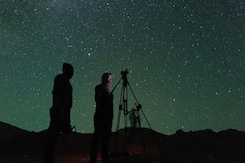Telescopes
- All
- News
- Videos
-

Webb Finds Phosphorus-Bearing Gas in an Ancient Brown Dwarf
- Monday November 10, 2025
- Written by Gadgets 360 Staff
NASA’s James Webb Space Telescope has detected phosphine (PH₃) in the atmosphere of the ancient brown dwarf Wolf 1130C, about 54 light-years away in Cygnus. This marks the first confirmed detection of a phosphorus-bearing gas in such a metal-poor object. The finding surprises astronomers, as phosphine was previously undetected in similar brown ...
-
 www.gadgets360.com
www.gadgets360.com
-

NASA's James Webb Space Telescope Telescope Challenges Old Theories on Mini-Neptune Worlds
- Friday November 7, 2025
- Written by Gadgets 360 Staff
New models suggest mini-Neptunes—planets smaller than Neptune with thick gas envelopes—may have solid rocky surfaces instead of molten magma. Data from NASA’s JWST revealed high-pressure atmospheres capable of compressing molten rock into solid crusts. This discovery challenges earlier assumptions and offers key insights into exoplanet compos...
-
 www.gadgets360.com
www.gadgets360.com
-

How Hot Was the Universe 7 Billion Years Ago? Scientists Now Have an Answer
- Wednesday November 5, 2025
- Written by Gadgets 360 Staff
Japanese astronomers using ALMA data have found the universe was about twice as hot 7 billion years ago, with a temperature of 5.13 K compared to today’s 2.7 K. The finding aligns perfectly with Big Bang predictions that the Universe cools as it expands, providing the most precise mid-epoch measurement yet and reinforcing confidence in standard c...
-
 www.gadgets360.com
www.gadgets360.com
-

Interstellar Visitor 3I/ATLAS Brightens Faster Than Expected, Surprising Scientists
- Tuesday November 4, 2025
- Written by Gadgets 360 Staff
The interstellar comet 3I/ATLAS has brightened far faster than expected during its solar approach, surprising researchers. Scientists say the unusual surge may point to rare chemical traits from another star system. Further observations in 2025 may reveal why this cosmic visitor behaves differently from typical comets in our solar neighbourhood.
-
 www.gadgets360.com
www.gadgets360.com
-

Hubble Observes Massive Stellar Eruption from EK Draconis, Hinting at Life’s Origins
- Sunday November 2, 2025
- Written by Gadgets 360 Staff
Astronomers using the Hubble Space Telescope observed a huge solar storm from EK Draconis, a young Sun-like star. The eruption’s energy may trigger atmospheric chemistry, forming greenhouse gases and organic molecules. Such events could mirror early solar activity that helped spark life on ancient Earth and distant exoplanets.
-
 www.gadgets360.com
www.gadgets360.com
-

Scientists May Have Finally Solved the Sun’s Mysteriously Hot Atmosphere Puzzle
- Thursday October 30, 2025
- Written by Gadgets 360 Staff
Scientists using the Daniel K. Inouye Solar Telescope have detected Alfvén waves in the Sun’s corona, potentially solving the long-standing mystery of its extreme heat and helping refine models of solar and stellar energy transfer.
-
 www.gadgets360.com
www.gadgets360.com
-

NASA’s JWST Produces First-Ever 3D Map of Distant Planet WASP-18b
- Monday November 3, 2025
- Written by Gadgets 360 Staff
NASA’s James Webb Space Telescope has created the first-ever 3D atmospheric map of an exoplanet, revealing the extreme conditions on WASP-18b, an “ultra-hot Jupiter” located 400 light-years away. Using infrared eclipse mapping, scientists discovered a scorching hotspot over 2,700 °C where water molecules are breaking apart. This groundbreaki...
-
 www.gadgets360.com
www.gadgets360.com
-

Scientists Detect Hidden Magnetic Waves That Could Explain the Sun’s Mysterious Heat
- Sunday November 2, 2025
- Written by Gadgets 360 Staff
For the first time, scientists have directly observed twisting Alfvén waves in the Sun’s corona using the Inouye Solar Telescope. The discovery could explain why the Sun’s outer atmosphere is millions of degrees hotter than its surface, offering key insights into solar energy transfer and space weather prediction.
-
 www.gadgets360.com
www.gadgets360.com
-

Harvard Scientist Reacts To New Observations Of Comet 3I/ATLAS, Fuels Alien Speculation
- Sunday October 26, 2025
- Science | Edited by Srishti Singh Sisodia
3I/ATLAS, believed to have originated from outside our solar system, was first detected in July 2025 by the ATLAS survey telescope.
-
 www.ndtv.com
www.ndtv.com
-

New Images of Interstellar Object 3I/ATLAS Show a Giant Jet Shooting Toward the Sun
- Sunday October 26, 2025
- Written by Gadgets 360 Staff
New telescope images show interstellar comet 3I/ATLAS ejecting a giant jet of gas and dust toward the Sun. Scientists say the phenomenon confirms its natural cometary behaviour, offering clues about how such ancient interstellar visitors react to solar heat.
-
 www.gadgets360.com
www.gadgets360.com
-

Flattened Dark Matter May Explain Mysterious Gamma-Ray Glow at Milky Way’s Core, Study Finds
- Sunday October 26, 2025
- Written by Gadgets 360 Staff
Dark matter near the Milky Way’s center appears flattened, not spherical, according to new simulations. The discovery may explain a puzzling gamma-ray glow long observed by NASA’s Fermi telescope, reigniting theories that dark matter collisions produce high-energy radiation in the galaxy’s core
-
 www.gadgets360.com
www.gadgets360.com
-

James Webb Telescope Finds Early Universe Galaxies Were More Chaotic Than We Thought
- Thursday October 23, 2025
- Written by Gadgets 360 Staff
The James Webb Space Telescope has revealed that galaxies in the early universe were far more chaotic and unstable than once believed. A new study shows that gas turbulence and intense star formation disrupted young galaxies, reshaping scientists’ understanding of how galaxies evolved into the structured systems seen today.
-
 www.gadgets360.com
www.gadgets360.com
-

NASA Telescopes Capture First-Ever Companion Star Orbiting Massive Red Supergiant Betelgeuse
- Sunday October 26, 2025
- Written by Gadgets 360 Staff
Astronomers have detected a small companion star orbiting the red supergiant Betelgeuse using Hubble and Chandra observations. Dubbed “Betelbuddy,” the discovery reveals an extreme binary system that challenges existing models of stellar evolution and may offer clues to Betelgeuse’s future.
-
 www.gadgets360.com
www.gadgets360.com
-

James Webb Telescope Uncovers the Turbulent Birth of the First Galaxies
- Saturday October 25, 2025
- Written by Gadgets 360 Staff
Using JWST data, astronomers analyzed more than 250 galaxies from the universe’s first 1.5 billion years and found most were chaotic, with gas swirling in all directions. Only a few showed early signs of ordered rotation. The findings reveal how intense star formation and gravitational turbulence gave way to stability, transforming the early univ...
-
 www.gadgets360.com
www.gadgets360.com
-

Harvard Scientist Weighs In On Interstellar Object 3I/ATLAS Emitting Strange Metal Alloy
- Sunday October 19, 2025
- Science | Edited by Srishti Singh Sisodia
The Keck II telescope data revealed distinct nickel and cyanide emissions around 3I/ATLAS.
-
 www.ndtv.com
www.ndtv.com
-

Webb Finds Phosphorus-Bearing Gas in an Ancient Brown Dwarf
- Monday November 10, 2025
- Written by Gadgets 360 Staff
NASA’s James Webb Space Telescope has detected phosphine (PH₃) in the atmosphere of the ancient brown dwarf Wolf 1130C, about 54 light-years away in Cygnus. This marks the first confirmed detection of a phosphorus-bearing gas in such a metal-poor object. The finding surprises astronomers, as phosphine was previously undetected in similar brown ...
-
 www.gadgets360.com
www.gadgets360.com
-

NASA's James Webb Space Telescope Telescope Challenges Old Theories on Mini-Neptune Worlds
- Friday November 7, 2025
- Written by Gadgets 360 Staff
New models suggest mini-Neptunes—planets smaller than Neptune with thick gas envelopes—may have solid rocky surfaces instead of molten magma. Data from NASA’s JWST revealed high-pressure atmospheres capable of compressing molten rock into solid crusts. This discovery challenges earlier assumptions and offers key insights into exoplanet compos...
-
 www.gadgets360.com
www.gadgets360.com
-

How Hot Was the Universe 7 Billion Years Ago? Scientists Now Have an Answer
- Wednesday November 5, 2025
- Written by Gadgets 360 Staff
Japanese astronomers using ALMA data have found the universe was about twice as hot 7 billion years ago, with a temperature of 5.13 K compared to today’s 2.7 K. The finding aligns perfectly with Big Bang predictions that the Universe cools as it expands, providing the most precise mid-epoch measurement yet and reinforcing confidence in standard c...
-
 www.gadgets360.com
www.gadgets360.com
-

Interstellar Visitor 3I/ATLAS Brightens Faster Than Expected, Surprising Scientists
- Tuesday November 4, 2025
- Written by Gadgets 360 Staff
The interstellar comet 3I/ATLAS has brightened far faster than expected during its solar approach, surprising researchers. Scientists say the unusual surge may point to rare chemical traits from another star system. Further observations in 2025 may reveal why this cosmic visitor behaves differently from typical comets in our solar neighbourhood.
-
 www.gadgets360.com
www.gadgets360.com
-

Hubble Observes Massive Stellar Eruption from EK Draconis, Hinting at Life’s Origins
- Sunday November 2, 2025
- Written by Gadgets 360 Staff
Astronomers using the Hubble Space Telescope observed a huge solar storm from EK Draconis, a young Sun-like star. The eruption’s energy may trigger atmospheric chemistry, forming greenhouse gases and organic molecules. Such events could mirror early solar activity that helped spark life on ancient Earth and distant exoplanets.
-
 www.gadgets360.com
www.gadgets360.com
-

Scientists May Have Finally Solved the Sun’s Mysteriously Hot Atmosphere Puzzle
- Thursday October 30, 2025
- Written by Gadgets 360 Staff
Scientists using the Daniel K. Inouye Solar Telescope have detected Alfvén waves in the Sun’s corona, potentially solving the long-standing mystery of its extreme heat and helping refine models of solar and stellar energy transfer.
-
 www.gadgets360.com
www.gadgets360.com
-

NASA’s JWST Produces First-Ever 3D Map of Distant Planet WASP-18b
- Monday November 3, 2025
- Written by Gadgets 360 Staff
NASA’s James Webb Space Telescope has created the first-ever 3D atmospheric map of an exoplanet, revealing the extreme conditions on WASP-18b, an “ultra-hot Jupiter” located 400 light-years away. Using infrared eclipse mapping, scientists discovered a scorching hotspot over 2,700 °C where water molecules are breaking apart. This groundbreaki...
-
 www.gadgets360.com
www.gadgets360.com
-

Scientists Detect Hidden Magnetic Waves That Could Explain the Sun’s Mysterious Heat
- Sunday November 2, 2025
- Written by Gadgets 360 Staff
For the first time, scientists have directly observed twisting Alfvén waves in the Sun’s corona using the Inouye Solar Telescope. The discovery could explain why the Sun’s outer atmosphere is millions of degrees hotter than its surface, offering key insights into solar energy transfer and space weather prediction.
-
 www.gadgets360.com
www.gadgets360.com
-

Harvard Scientist Reacts To New Observations Of Comet 3I/ATLAS, Fuels Alien Speculation
- Sunday October 26, 2025
- Science | Edited by Srishti Singh Sisodia
3I/ATLAS, believed to have originated from outside our solar system, was first detected in July 2025 by the ATLAS survey telescope.
-
 www.ndtv.com
www.ndtv.com
-

New Images of Interstellar Object 3I/ATLAS Show a Giant Jet Shooting Toward the Sun
- Sunday October 26, 2025
- Written by Gadgets 360 Staff
New telescope images show interstellar comet 3I/ATLAS ejecting a giant jet of gas and dust toward the Sun. Scientists say the phenomenon confirms its natural cometary behaviour, offering clues about how such ancient interstellar visitors react to solar heat.
-
 www.gadgets360.com
www.gadgets360.com
-

Flattened Dark Matter May Explain Mysterious Gamma-Ray Glow at Milky Way’s Core, Study Finds
- Sunday October 26, 2025
- Written by Gadgets 360 Staff
Dark matter near the Milky Way’s center appears flattened, not spherical, according to new simulations. The discovery may explain a puzzling gamma-ray glow long observed by NASA’s Fermi telescope, reigniting theories that dark matter collisions produce high-energy radiation in the galaxy’s core
-
 www.gadgets360.com
www.gadgets360.com
-

James Webb Telescope Finds Early Universe Galaxies Were More Chaotic Than We Thought
- Thursday October 23, 2025
- Written by Gadgets 360 Staff
The James Webb Space Telescope has revealed that galaxies in the early universe were far more chaotic and unstable than once believed. A new study shows that gas turbulence and intense star formation disrupted young galaxies, reshaping scientists’ understanding of how galaxies evolved into the structured systems seen today.
-
 www.gadgets360.com
www.gadgets360.com
-

NASA Telescopes Capture First-Ever Companion Star Orbiting Massive Red Supergiant Betelgeuse
- Sunday October 26, 2025
- Written by Gadgets 360 Staff
Astronomers have detected a small companion star orbiting the red supergiant Betelgeuse using Hubble and Chandra observations. Dubbed “Betelbuddy,” the discovery reveals an extreme binary system that challenges existing models of stellar evolution and may offer clues to Betelgeuse’s future.
-
 www.gadgets360.com
www.gadgets360.com
-

James Webb Telescope Uncovers the Turbulent Birth of the First Galaxies
- Saturday October 25, 2025
- Written by Gadgets 360 Staff
Using JWST data, astronomers analyzed more than 250 galaxies from the universe’s first 1.5 billion years and found most were chaotic, with gas swirling in all directions. Only a few showed early signs of ordered rotation. The findings reveal how intense star formation and gravitational turbulence gave way to stability, transforming the early univ...
-
 www.gadgets360.com
www.gadgets360.com
-

Harvard Scientist Weighs In On Interstellar Object 3I/ATLAS Emitting Strange Metal Alloy
- Sunday October 19, 2025
- Science | Edited by Srishti Singh Sisodia
The Keck II telescope data revealed distinct nickel and cyanide emissions around 3I/ATLAS.
-
 www.ndtv.com
www.ndtv.com






